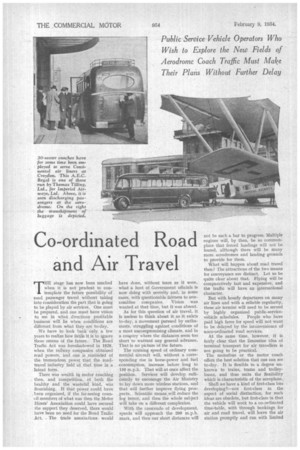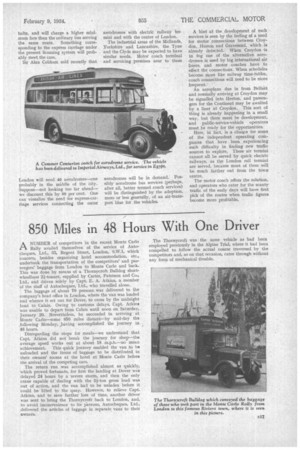Co-ordinated Road and Air Travel
Page 114

Page 115

If you've noticed an error in this article please click here to report it so we can fix it.
THE stage has now been reached when it is not prudent to contemplate the future possibility of road passenger travel without taking into consideration the part that is going to be played by air services. One must be prepared, and one must have vision to see in what directions profitable business will lie when conditions are different from what-they are to-day..
We have to look back only a few years to realize how futile it is to ignore these omens of the future. The Road Traffic Act was foreshadowed in 1928, when the railWay companies obtained road powers, and one is reminded of the tremendous power that the roadtravel industry held at that time in 'a latent form. .
There was wealth in motor coaching then, and 'competition, of both the healthy and the wasteful kind, Was flourishing. If that power could have _been organized, if the far-seeing council members of what was then the Motor Hirers' Association could have secured the support they deserved, there would have been no need for the Road Traffic Act. . The trade associations, would
have done, without tears as it were, what a host of Government officials is now doing with severity and, in some cases, with questionable fairness to noncombine companies. Vision was wanted at that time, but it was absent.
As for this question of air travel, it _is useless to think about it as it exists to-day, a movement pursued by enthusiasts, struggling against conditions of a most uncompromising climate, and in a country where the distances seem too short to warrant any general advance. That is no picture of the future.
The cruising speed of ordinary commercial aircraft will, without a corresponding rise in horse-power and fuel .consumption, increase before long to 150 m.p.h. That will at once affect the position. Services will develop sufficiently to encourage the Air Ministry to lay down more wireless stations, and that will further improve flying pros.pects. Scientific means ,will reduce the fog terror, and then the whole subject will take on a different complexion.
With the crescendo of development, speeds will approach the 200 m.p.h. mark, and then our short distances will
not be such a bar to progress. Multiple engines will, by then, be so commonplace that forced landings will not be feared, although there will be many more aerodromes and landing grounds to provide for them.
What will happen about road travel then? The attractions of the two means for conveyance are distinct. Let us be quite clear about that. Flying will be comparatively fast and expensive, and the traffic will have an international character.
But with hourly departures on many air lines and with a reliable regularity, these air termini will need to be served by highly organized public-servicevehicle schedules.. People who have paid high fares for speed will not want to be delayed by the inconvenience of unco-ordinated road services.
At the same time, however, it is fairly clear that the limousine idea of terminal transport for air travellers is not going to be practical.
The motorbus or the motor coach offers the best solution that one can see to-day. It is flexible to a degree unknown to trains, trams and trolleybuses, and thus suits the flexibility which is characteristic of the aeroplane.
Shall we have a kind of first-class bus developing?—not first-class in the aspect of social distinction, for such ideas are obsolete, but first-class in that the vehicle will work to a co-ordinated time-table, with through bookings for air and road travel, will leave the air station promptly and run with limited halts, and will charge a higher minimum fare than the ordinary bus serving the same route. Something corresponding to the express carriage under the present licensing system will probably meet the case.
Sir Alan Cobham said recently that London will need 40 aerodromes—one probably in the middle of the city. Suppose—not looking too far ahead— we discount this by 50 per cent. One can visualize the need for express-carriage services connecting the outer aerodromes with electric railway termini and with the centre of London.
The industrial areas of the Midlands, Yorkshire and Lancashire. the Tyne and the Clyde may be expected to have similar needs. Motor coach terminal and servicing premises near to these aerodromes will be in demand. Possibly aerodrome bus services (perhaps, after all, better termed coach services) will be distinguished by the adoption, more or less generally, of an air-transport blue for the vehicles. A hint at the development of such services is seen by the feeling of a need for motor connections between Croydon, Heston and Gravesend, which is already detected. When Croydon is in fog one of the alternative aerodromes is used by big international air liners, and motor coaches have to effect the connections. When schedules become more like railway time-tables, coach connections will need to be more frequent.
An aeroplane due in from BeHaat and normally arriving at Croydon may be signalled into Heston,. and passengers for the Continent may be awaited by a liner at Croydon. This sort of thing is already happening in a small way, but there must be development, and public-service-vehicle operators must be ready for the opportunities.
Here, in fact, is a chance for some of the independent operating companies that have been experiencing such difficulty in finding new traffic sources to explore. These air termini cannot all be served by quick electric railways, as the London rail termini are served, because most of them will be much farther out from the town centre.
The motor coach offers the solution, and operators who cater for the scanty traffic of the early days will have first pick of the routes when traffic figures become more profitable.




































































































































































